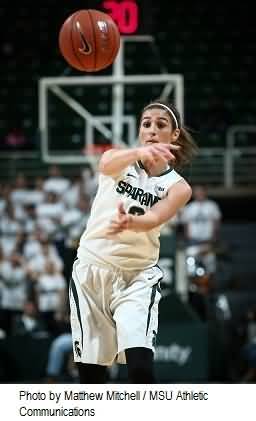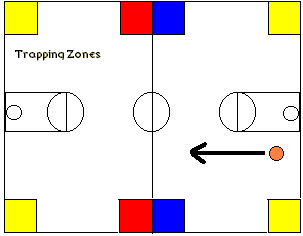Attacking the Full Court Press
By Dr. James Gels, from the Coach’s Clipboard Basketball PlaybookFull court press defenses try to force turnovers and get easy baskets by pressuring, trapping, and harassing the offense. Here are several principles and some strategies in beating this pressure.
Stay calm. The press tries to upset you, and make you commit turnovers. Be calm and confident that you can beat this. If you make a mistake, forget it and stay calm. Otherwise, they may force even more turnovers from you, like a snowball effect.
Do not dwell on what's already happened always think "next play", what is going to happen next. The coach must stay calm too. An upset, angry coach is not what the already rattled players need. In a time-out, the coach must be calm, reassure, re-focus his players, and settle his players down.
Think "attack!". A full court press is always a gamble for the defense. If you think positive, and attack the pressure, you can get an easy lay-up. So when you see a press coming at you, ATTACK! Think of it as something to beat, to get an easy score - make 'em pay!
We like to attack the press with quick passing as this can get you a 2-on-1 situation and a lay-up. Sometimes you have to beat the press with the dribble, but then you are less likely to get the lay-up. So think pass first.
Three "looks".
When receiving the inbounds pass, catch it and get into triple-threat position facing the defense and look up the floor before immediately starting your dribble.
1. Look up. See the floor. Look up the court. Don't look down at the ball.
2. Look before you pass. Make good, quick safe passes.
3. Look before you dribble. Don't dribble unless you have to. You beat the press by quick, sharp passing usually not dribbling.
Getting the ball inbounds. Get the ball in quickly, before the defense can set up. Make sure you make a good inbounds pass. Do not take the ball out from directly under your basket, or your passing lane may be restricted by the backboard. If the other team has just scored, you may "run the baseline".
You cannot run the baseline if the ball went out of bounds and the official is handing it to you. You must stay where the ref gives it to you. If the ref doesn't handle it (like after a score), you can use the whole baseline. You can run the baseline after a time-out, if the time-out was called immediately after the opponent scored.
To receive the inbounds pass, the point guard must get open. Too often I see young point guards trying to get open by running away from the defender, which is usually unsuccessful. Instead, our point guard should walk up to the defender, make contact with the defender (get a forearm into the defender) and then "bounce-off" off the defender to get open. If the point guard is being aggressively denied, he/she can walk the defender down almost to the baseline, seal and quickly release long for the over-the-top lob pass.
When receiving the inbounds pass, we teach our receiver to get into "triple-threat position" after receiving the pass, rather than just putting the head down and starting to dribble. Getting into triple-threat allows the receiver the "three looks" disussed above, to see the defense, see our receivers, and still have the dribble option.
Avoid "trap areas"... the corners. Don't dribble into one of the trap areas (see below)... back away but keep your dribble alive, or pass off.
If you find yourself in a trap.. (1) do not turn your back to the defenders as this allows them to close the gap on you and you cannot see your teammates to pass the ball. Instead, face the defenders, and keep the ball low and moving and keep your body moving using your pivot foot; (2) Stay low and do not stand upright with the ball over your head, as this also allows the defenders to immediately close in on you.
If you have your dribble, you can (1) attack the outside leg of one of the defenders and dribble by, or (2) split the double-team by making an aggressive "step-thru" with one leg between the defenders, with head and shoulders bent over forward, cradling and protecting the ball like a football halfback going through the line, and then push the ball out in front of you starting your dribble. See Escaping a Trap.

Pass quickly up the court
Receivers meet the pass... go to the ball, get open. But keep your spacing. Look for the open spots in the defense. Get open so your teammate can pass to you. Before you even get the ball, look to see where other open teammates are, so you will know where to pass to immediately. When you receive the ball, don't have your back turned. Immediately pivot and face down-court, so you can find an open teammate.
Use the whole court and reverse the ball to the opposite side. Keep at least one player on the "weak-side" to reverse the ball to the opposite side of the court.
Have a standard "press break" offense that works for you, so you can immediately recognize the press and yell "press break" to your team. Here are several press breakers to choose from:
- 80-60-40 press breakers... this is really all you need.
- 1-1-2-1 press breaker
- 4-across press breaker
- 1-2-1-1 press breaker
Remember, stay calm, see the floor, pass quickly, make sharp cuts, and "ATTACK!"
Avoid the "trapping zones" seen in this diagram.
- Avoid the corners (yellow).
- If you get trapped in the blue zones, you risk the 10 second call.
- The red zones are just like getting caught in the yellow corners... you are trapped by the sideline and the center line.

Another way to beat the press is to use the "secondary" fast break (see "Secondary Break"). Get the ball in quickly before the press is set defensively, then a good long pass up the sideline and you've got a lay-up.
Related pages:
- Transition Offense
- 80-60-40 press breakers... this is really all you need.
- 3-Up Press-Break
- Simple press breaker
- 4-across press breaker
- 1-2-1-1 Diamond Press breaker
- 2-2-1 Press-Breaker